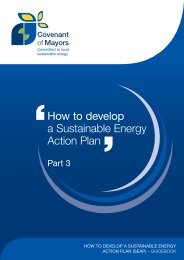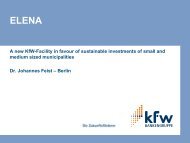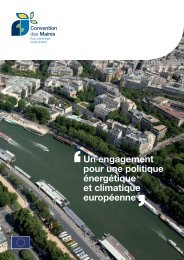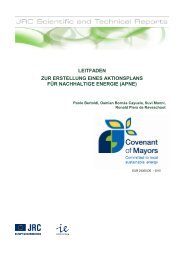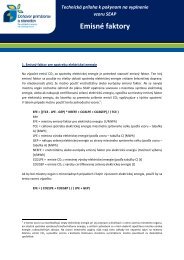English - Covenant of Mayors
English - Covenant of Mayors
English - Covenant of Mayors
Create successful ePaper yourself
Turn your PDF publications into a flip-book with our unique Google optimized e-Paper software.
7. Recalculations<br />
In general, once the BEI is completed, there is no need to<br />
change the numbers later on. By using similar methods<br />
also in the MEI, the local authority can ensure that the<br />
results are consistent, and thus the difference between MEI<br />
and BEI correctly reflects the changes <strong>of</strong> emissions<br />
between the baseline year and the monitoring year.<br />
However, there are a few occasions when recalculation <strong>of</strong><br />
BEI is needed to ensure consistency between the emission<br />
estimates <strong>of</strong> BEI and MEI. Examples <strong>of</strong> such occasions are:<br />
• industry delocalisation;<br />
• new information on emission factors;<br />
• methodological changes;<br />
• changes in the local authority’s boundaries.<br />
Emission reductions due to industry delocalisation are<br />
explicitly excluded from the <strong>Covenant</strong> <strong>of</strong> <strong>Mayors</strong>. In these<br />
guidelines, industry delocalisation means a full and<br />
permanent closure <strong>of</strong> an industrial plant, the emissions <strong>of</strong><br />
which represented more than 1 % <strong>of</strong> the baseline<br />
emissions. An example <strong>of</strong> recalculation due to industry<br />
delocalisation is presented in Box 8.<br />
Recalculation due to new information on emission factors<br />
or methodological changes has to be carried out only in<br />
the case that the new information reflects the situation in<br />
the baseline year more accurately than the information<br />
used in compilation <strong>of</strong> BEI (see Box 9). If real changes in<br />
emission factors have occurred between the baseline year<br />
and the monitoring year – for instance due to the use <strong>of</strong><br />
different fuel types – then different emission factors will<br />
correctly reflect the changed circumstances, and<br />
recalculation is not needed ( 14 ).<br />
BOX 8. RECALCULATION DUE TO INDUSTRY DELOCALIZATION<br />
The local authority decided to include emissions from industrial plants not included in EU ETS in the BEI, because<br />
the SEAP included measures to improve energy efficiency in the plants. However, one <strong>of</strong> the plants (Plant A), the<br />
emissions <strong>of</strong> which were 45 kt CO 2<br />
in the baseline year (1.4 % <strong>of</strong> the baseline emissions), closed down before the<br />
monitoring year. Inclusion <strong>of</strong> this emission source in BEI but excluding it from MEI would mean that the local<br />
authority would gain benefit due to industry delocalisation. Therefore, the local authority has to recalculate the<br />
baseline year emissions so that the emissions <strong>of</strong> Plant A are excluded.<br />
29<br />
THE BEI OF THE LOCAL AUTHORITY, AS<br />
REPORTED IN SEAP WAS AS FOLLOWS<br />
IN THE RECALCULATED BEI INVENTORY, THE<br />
EMISSIONS OF PLANT A HAVE BEEN REMOVED<br />
AND THE INVENTORY IS AS FOLLOWS<br />
CATEGORY<br />
CO 2<br />
EMISSIONS<br />
(kt)<br />
CATEGORY<br />
CO 2<br />
EMISSIONS<br />
(kt)<br />
Residential buildings 2 000<br />
Residential buildings 2 000<br />
…<br />
…<br />
…<br />
…<br />
Industries (excluding<br />
industry part <strong>of</strong> EU Emission<br />
trading scheme)<br />
70<br />
Industries (excluding<br />
industry part <strong>of</strong> EU Emission<br />
trading scheme)<br />
25<br />
Subtotal buildings,<br />
facilities and industry<br />
2 735<br />
Subtotal buildings,<br />
facilities and industry<br />
2 690<br />
…<br />
…<br />
Subtotal transport 500<br />
Total 3 235<br />
Subtotal transport 500<br />
Total 3 190<br />
(14) Extensive guidance for recalculation is given in the chapter ‘Time series consistency’ <strong>of</strong> IPCC (2006), available at<br />
http://www.ipcc-nggip.iges.or.jp/public/2006gl/pdf/1_Volume1/V1_5_Ch5_Timeseries.pdf




